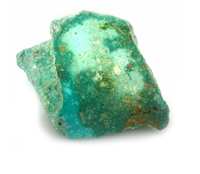 |
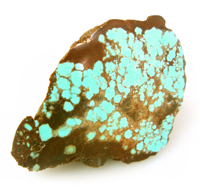 |
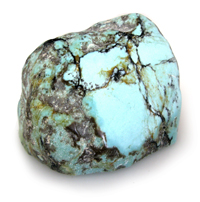 |
| Alexia Turquoise - Mexico | #8 Turquoise - Nevada, U.S.A. | Zacatacas - Mexico |
|
Turquoise Turquoise is an opaque, blue-to-green mineral that is a hydrous phosphate of copper and aluminum. It is rare and valuable in finer grades and has been prized as a gem and ornamental stone for thousands of years owing to its unique hue. Even the finest of turquoise is fracturable, reaching a maximum hardness of just under 6, or slightly more than window glass. The luster of turquoise is typically waxy to subvitreous, and transparency is usually opaque. Color is as variable as the mineral's other properties, ranging from white to a powder blue to a sky blue, and from a blue-green to a yellowish green. The blue is attributed to copper while the green may be the result of either iron or nickel impurities. Hardness and richness of color are two of the major factors in determining the value of turquoise; while color is a matter of individual taste, generally speaking, the most desirable is a strong sky to "robin's egg" blue. The mother rock or matrix in which turquoise is found can often be seen as splotches or a network of brown or black veins running through the stone in a netted pattern; this veining may add value to the stone if the result is complementary, but such a result is uncommon. Such material is sometimes described as "spider web matrix". The pastel shades of turquoise have endeared it to many great cultures of antiquity: it has adorned the rulers of Ancient Egypt, Aztecs and possibly other Pre-Columbian Mesoamericans, Persia, Mesopotamia, the Indus Valley, and to some extent in ancient China since at least the Shang Dynasty. Despite being one of the oldest gems, probably first introduced to Europe through Turkey with other Silk Road novelties, turquoise did not become important as an ornamental stone in the West until the 14th century. It was apparently unknown in India until the Mughal period, and unknown in Japan until the 18th century. A common belief shared by many of these civilizations held that turquoise possessed certain prophylactic qualities; it was thought to change color with the wearer's health and protect him or her from untoward forces. Turquoise was among the first gems to be mined, and while many historic sites have been depleted, some are still worked to this day. These are all small-scale, often seasonal operations, owing to the limited scope and remoteness of the deposits. Most are worked by hand with little or no mechanization. However, turquoise is often recovered as a byproduct of large-scale copper mining operations. For at least 2,000 years, the region once known as Persia, has remained the most important source of turquoise, for it is here that fine material is most consistently recovered. A weathered and broken trachyte is host to the turquoise, which is found both in situ between layers of limonite and sandstone, and amongst the scree at the mountain's base. These workings, together with those of the Sinai Peninsula, are the oldest known. Iranian turquoise is often found replacing feldspar. Although it is commonly marred by whitish patches, its color and hardness are considered superior to the production of other localities. Iranian turquoise has been mined and traded abroad for centuries, and was probably the source of the first material to reach Europe. |
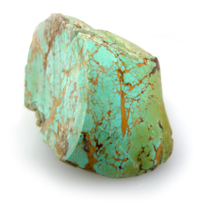 |
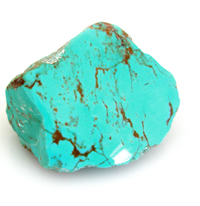 |
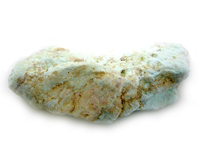 |
| Maanshan Tuquoise - China | Turquoise Nugget - Mexico | Campitos Chaulk - Mexico |
|
China has been a minor source of turquoise for 3,000 years or more. Gem-quality material, in the form of compact nodules, is found in the fractured, silicified limestone of Yunxian and Zhushan, Hubei province. Additionally, Marco Polo reported turquoise found in present-day Sichuan. Most Chinese material is exported, but a few carvings worked in a manner similar to jade exist. In Tibet, gem-quality deposits purportedly exist in the mountains of Derge and Nagari-Khorsum in the east and west of the region respectively. Other notable localities include: Afghanistan; Australia, northern Chile, Cornwall, Saxony, Silesia, and Turkestan. The Southwest United States is a significant source of turquoise; Arizona, California, Colorado, New Mexico and Nevada are or were especially rich. The deposits of California and New Mexico were mined by pre-Columbian Native Americans using stone tools, some local and some from as far away as central Mexico. Cerrillos, New Mexico is thought to be the location of the oldest mines; prior to the 1920s, the state was the country's largest producer; it is more or less exhausted today. Only one mine in California, located at Apache Canyon, operates at a commercial capacity today. Arizona is currently the most important producer of turquoise by value. Two mines exist in the state, one is the Sleeping Beauty Mine in Globe, the other is the Kingman Mine that operates alongside a copper mine outside of the city. Nevada is the country's other major producer, with more than 120 mines which have yielded significant quantities of turquoise. Unlike elsewhere in the US, most Nevada mines have been worked primarily for their gem turquoise and very little has been recovered as a byproduct of other mining operations. While a number of the Nevada deposits were first worked by Native Americans, the total Nevada turquoise production since the 1870s has been estimated at more than 600 tons, including nearly 400 tons from the Carico Lake mine. In spite of increased costs, small scale mining operations continue at a number of turquoise properties in Nevada, including the Godber, Orvil Jack and Carico Lake Mines in Lander County, the Pilot Mountain Mine in Mineral County, and several properties in the Royston and Candelaria areas of Esmerelda County. Only 25% of turquoise is usable in its natural form. Turquoise is a fragile, porous stone with a tendency to undergo changes in color when exposed to light, perspiration, oils, water and detergents. Being a phosphate mineral, turquoise is inherently fragile and sensitive to solvents; perfume and other cosmetics will attack the finish and may alter the color of turquoise gems, as will skin oils, as will most commercial jewelry cleaning fluids. Prolonged exposure to direct sunlight may also discolor or dehydrate turquoise. Care should therefore be taken when wearing such jewels: cosmetics, including sunscreen and hair spray, should be applied before putting on turquoise jewelry, and they should not be worn to a beach or other sun-bathed environment. After use, turquoise should be gently cleaned with a soft cloth to avoid a buildup of residue, and should be stored in its own container to avoid scratching by harder gems. Turquoise can also be adversely affected if stored in an airtight container. ~Natural turquoise has never been treated, it’s in its “from the ground” form. ~Enhanced Turquoise is a hard turquoise which is treated with varying electrical currents that harden the stone, and enhance the color of the turquoise. No dyes, resins, waxes or oils are used. Enhanced turquoise will not change color over time. ~Stabilized is turquoise that is impregnated with acrylic or epoxy to harden the stone and enhance the color. Stabilized turquoise will not change color overtime. ~Compressed is a treatment that uses pressure to harden the stone. ~Fracture-Sealed is when the stone is treated with a fracture sealer which hardens the matrix in it. ~Reconstituted Turquoise is the process of taking pieces of turquoise, chips, powder or low grade, mix with an epoxy resin and add dye the compress into blocks. ~Color Enhanced is turquoise that has been stabilized and dyed to a specific or degree of color. ~Waxing and Oiling were the first treatments used in ancient times, providing a wetting effect, thereby enhancing the color and luster. This treatment is more or less acceptable by tradition, especially because treated turquoise is usually of a higher grade to begin with. Oiled and waxed stones are prone to "sweating" under even gentle heat or if exposed to too much sun and they may develop a white surface film or bloom over time. (With some skill, oil and wax treatments can be restored.) |
| Anhui Turquoise – Anhui Province, China The mine for this Anhui turquoise is in the northwest of East China, along Yangtze River Basin. This in a very remote area in Northern China, and has to be mined by hand and brought out to the nearest road in packs. The Anhui province is poor when compared to others in East China, but it is rich in agriculture. The mine has just recently been opened and produces these natural high blues. The more copper present in the turquoise the bluer it is. The mines are deep under the ground, 100 meters, in which the miners have to drill deep holes to obtain the material. |
||
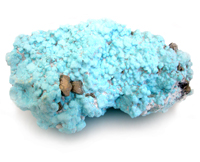 |
Campitos Azure – Sonora, Mexico This is a clear turquoise from Pino Chueco mine in Sonora, Mexico which resembles the deep blues of Sleeping Beauty. It is medium light-blue with no matrix and a little pyrite. The turquoise is very unique in that it is found as free-form nuggets in clay material, rather than in rock veins. The mine has produced this turquoise, since the mid-1980s. Archaeology also shows that Southwestern peoples mined these deposits extensively. There are also historical traces of Native American turquoise mining. |
|
| Green Chinese, Hubei Province, China Green Chinese turquoise is mined in the north west of Hubei province, near to the city of Shiyan. It is near to Wudangshan (Wudang Mountain) which is famous for Taiji. This is a small surface deposit of turquoise that was discovered while looking for Iron ore. This region yields the richest Iron deposits. It is natural turquoise that yields this beautiful color due to the high iron content present. |
||
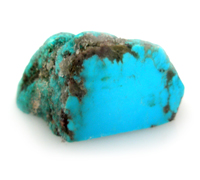 |
Kingman Turquoise – Kingman Arizona, USA |
|
| Mojave Turquoise comes from the “Mineral Park” deposit in Kingman Arizona. The turquoise is color enhanced to give it a beautiful spring green look. | 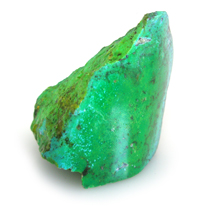 |
|
| Nacasari “Nako” Turquoise - Mexico The Nacasari mine is located in north western Mexico, in a large open pit copper mine. The mine yields mainly high blue with clear and black matrix materials. Its high content of copper in the material is what makes it such a high blue color. Because of an unstable political situation in this region, the mine and local government has stopped the mining of the rough, and if caught with the rough it is confiscated. |
||
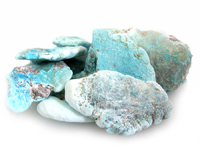 |
Sleeping Beauty, Globe Arizona U.S.A. This is natural Sleeping Beauty turquoise, which is mined in Globe Arizona. It comes from a mine that looks like a woman sleeping on her back, hence the name. It is almost mined out, and the material is becoming quite rare. |
|
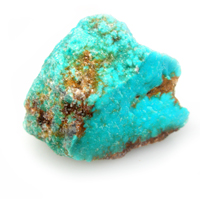 |
||
Desert Rosing Trading. All Rights Reserved.

